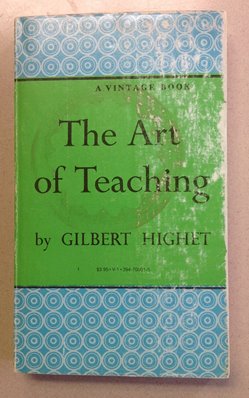
Years ago Fr. Kenneth Styles, S.J., the then-Principal of Saint Ignatius gave to each teacher the gift of Gilbert Highet’s
The Art of Teaching. Highet, a Scottish-born Classicist and Oxford educated professor, was a part of a golden age of the liberal arts at Colombia University. He, along with the likes of Lionel Trilling and Mark Van Doren, were among those who made Colombia a leading voice for what has become known as the Western Canon or the Great Books.
I, as a young teacher who had taken exactly zero education courses prior to the rather insane decision by Theology Department Chair Jim Skerl ’74 and President Fr. Robert Welsh ‘54 to hire me in the Spring of 1981, was thrilled to have in my hands such a master work on the profession – or, rather, the ministry – that I had fallen into.
The Art of Teaching was my Rosetta Stone and has, along with a handful of other texts, guided my 37-year career.
The importance of such a text came to mind yesterday as I sat in Room 229 Loyola Hall, officially known as the Castele Conference Room, and saw the fruits of the art of teaching as practiced by Anthony Fior ’02. Anthony teaches the introductory Theology course to Freshmen and sacraments to Juniors, but the reason that I was in his classroom was to observe and critique the student presentations in his Junior AP Research course, the companion to the Sophomore AP Seminar class guided by Assistant Principal for Faculty Formation Tom Beach.
Not only is it a joy for me to be in the room while these young men present their research on topics as wide-ranging as the effects of the growth of genetically modified Bt cotton in the Maharastra region of India to the ethics of the removal of Confederate statues in the South, but it is a privilege to be witness to the first group of young men to participate in this new facet of the AP program at Saint Ignatius.
These stellar Wildcats have spent this semester learning how to do research from a man who himself had to go through the process himself during his recent doctoral studies in education. ‘Doc’ Fior has masterfully practiced the art of teaching as he brought these very bright – but very untrained in the methods of scholarly research – young men to the point where they can offer papers and presentations that would not be out of place in the classrooms of the highly selective universities to which these young men aspire.
At this time of year when (to paraphrase Michael Stanley) cold Ohio mornings are still making everything gray, the exuberance of these young men as they make their presentations can be wonderfully infectious. In a world of dry educational jargon like “higher-order thinking”, “text complexity”, “student progress monitoring”, and “rigor” it is invigorating to an old teacher like myself when those concepts are given life in a classroom. It is also heartening to recall that, despite the newness of the jargon, those concepts have been a part of Jesuit education from the very beginning.
In
The Art of Teaching the humorous Highet says, “I have already praised Jesuit education so much that it must be obvious I am not a Jesuit myself, or even a Roman Catholic.” For Highet, the greatness of a Jesuit education lies in planning and adaptability, as well as the high standard of both the books studied and the achievement demanded from the students. In this he is describing the work of pedagogical artist Doc Fior and the results that his students have brought forth.
In many ways Saint Ignatius is the same school that it was in 1886 when our doors first opened: the standards of education to which Dr. Highet referred are still the hallmarks of our educational enterprise. Yet because of the Jesuit commitment to adaptability, courses like AP Research have been added to the curriculum. These courses not only highlight the exceptional abilities of our young men, but also prove – against the grain of much of society’s vision of education – that it is not the educator as technocrat that is needed in the classroom, but instead a teacher as artist.
A.M.D.G.